Latest News
Behind The Scenes: The Miners’ Gala Mural

Earlier this year we published the complete story of The Miners’ Gala Mural in a series of weekly chapters to coincide with the relocation of The Mural from County Hall to Bishop Auckland Town Hall. The Mural moved on March 14th and then life changed on March 17th as the lockdown started.
Bishop Auckland Town Hall re-opened on August 3rd and a short summary of the story of The Miners’ Gala Mural follows. Originally prepared in May 2019 for Visit Durham, delayed until the relocation, and now published for the first time to support the opening of Bishop Auckland Town Hall.
This iconic Mural was commissioned in 1962 by Durham County Council to coincide with the opening of the new County Hall in October 1963 by The Duke of Edinburgh. Norman’s agent at the time considered that the painting would become the cornerstone of his career and it was quite appropriate in his centenary year, that the Mural found a new home in 2020, as Durham County Council prepared to relocate to a new County Hall in Durham City.
In 1962 the coal industry was in decline and Norman was also under pressure from his agent Mick Marshall at The Stone Gallery in Newcastle to become a full time professional artist – such was the demand for his work and a burgeoning national reputation. Becoming a professional artist introduced different risks compared to those he faced underground on a daily basis. His house was ‘tied to the mine’ and irregular income added to the insecurity of making the ‘big step’ from miner to professional artist.
One day, working at the coal- face at Mainsforth Colliery, Ferryhill, he was summoned to receive an important telephone call from Durham County Council to commission Norman to paint a Mural typifying life in County Durham, for the new county hall.
Initially reluctant, he received support from his wife Sarah and also from Bob Heslop and Bert Dees who were also members of The Spennymoor Settlement Sketching Club. Norman was granted ‘leave of absence’ for twelve months, without pay, which sadly confirmed his view that the miners were treated like slaves.
The commission was conducted in secrecy and he was given permission to use a former church hall as a studio although it was draughty and without heating. Norman had to acquire his own materials including the canvas, which measured 30 feet 9 inches by 5 feet 8 inches. Norman didn’t own a telephone and letters were the only means of communication to suppliers of materials.
Four mining related subject themes were initially suggested by the County Council but Norman made an inspired choice with the arrival of the banners at The Race Course at The Durham Big Meeting- The Miners’ Gala.
Norman visualised the banners as representing the sails of a galleon with three waves of people in the sea of humanity below. All depicted with an undulating rhythm and counter rhythm to suggest movement.
The young people in the wave to the left represent the present and look towards the centre- the future. The elderly folk to the right, representative of the past, turn to the bold central banner which bears the slogan “Unity is Strength’- a symbol of the future. The whole scene represents an allegory of time.
Norman developed his composition by producing preliminary drawings and paintings based upon observations which become smaller versions of the final composition. This allowed Norman to be confident that by a series of steps, the final full -scale version actually worked in terms of the relationship between the figures and the overall composition.
Most of the work was completed during the coldest winter in 40 years and sometimes icicles had to be broken to access the hall. Often, Norman had to wear several coats to keep warm, a muffler, cap and gloves. A secret knock was devised to enable his closest friends to view the work in progress and offer helpful comments.
During his research, Norman made numerous drawings of Spennymoor Town Band members in rehearsal to ensure absolute accuracy. At a later stage he added himself and his son John, on his shoulders, (left hand side) as observers rather than participants, who are fundamental to the composition. It was important for Norman to depict himself as being part of the miners’ annual celebrations that reinforced his sense of belonging, involvement and affinity with his subject. One of the most significant artists to influence Norman was Rembrandt who included himself in The Night Watch.
The Mural has been on display at Durham County Hall since the opening in 1963. During 2020 The Mural will be re-located to Bishop Auckland Town Hall where a fully accessible permanent exhibition will be installed during the refurbishment works. The display will be supported by previously unseen preparatory works, and correspondence from the Norman Cornish archive, for the public benefit, as part of an extended exhibition.
The Miners’ Gala Mural is a highly significant work of art that goes to the very heart of Durham culture and which evokes deepening and strengthening emotional attachments for many people who identify with this inspirational record of a bygone era.

A Missing Link
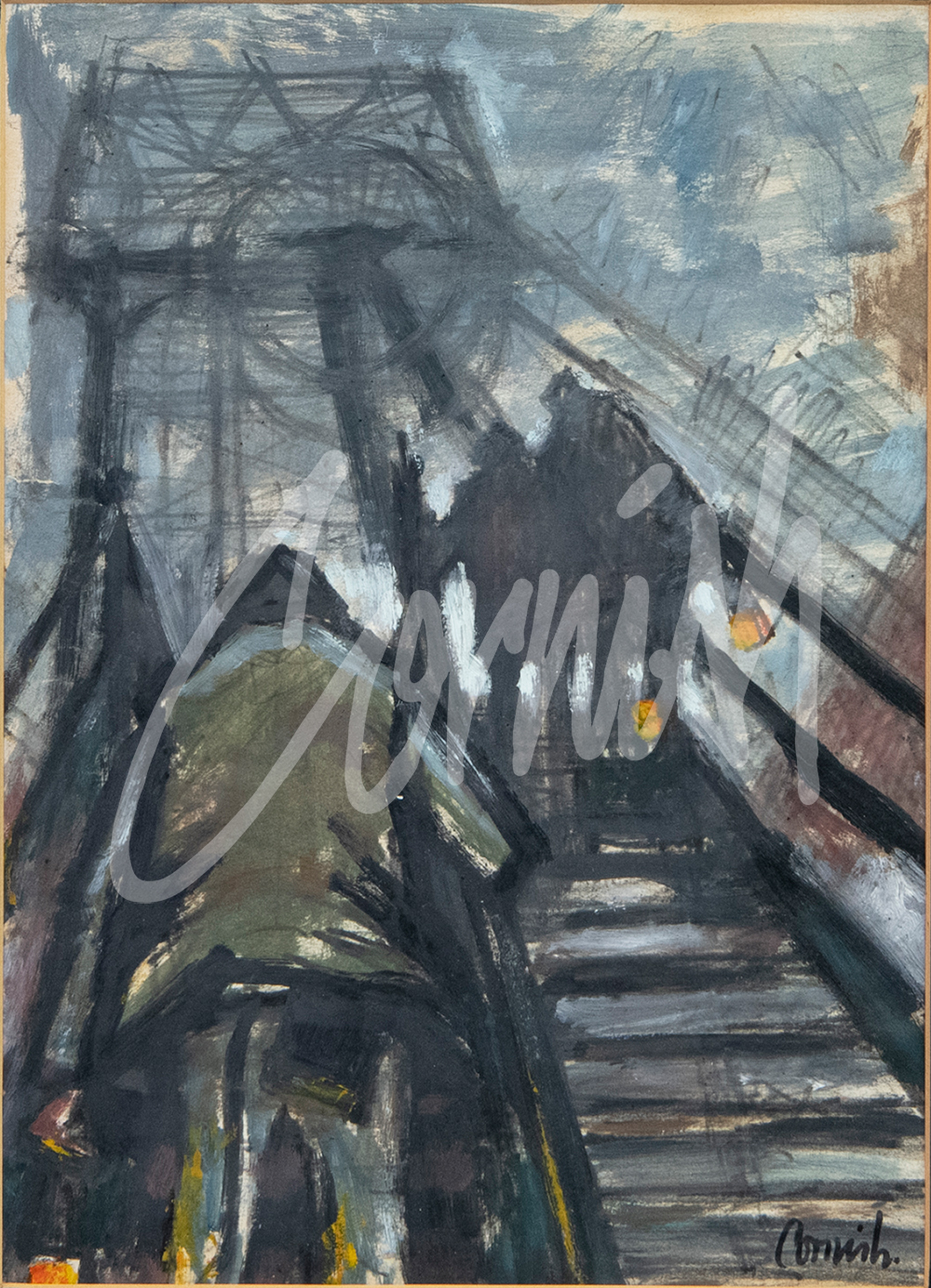
In 1964, a very astute artist added to his collection of paintings by purchasing a version of The Gantry by Norman Cornish. The painting cost 30 Guineas (equivalent today of £2,000+) in an exhibition at The Stone Gallery in Newcastle, and the buyer was Laurence Stephen Lowry.
Lowry was an English artist and many of his paintings and drawings depict Pendlebury and the vicinity of Salford, Lancashire, where he lived and worked for 40 years. Lowry depicted scenes of life in industrial NW England and he was a lonely man depicting loneliness. He began his working career as a rent collector and he was perceived as an outsider in his community looking in on his subjects. Cornish painted life in the NE of England but he was immersed in his community where he recorded everyday life. At work – working underground as a miner during the day, and in the evenings and weekends, spending his leisure time in the pubs of Spennymoor with his marras (workmates). The beer in Cornish’s glass became the passport to be able to share, observe and record the life around him. Because he could blend in, this gave him the opportunity to produce so many character drawings in different settings.
Mr. Cornish and Mr Lowry (always formal) were well known to each other and they first exhibited together in Carlisle in 1951 at Tullie House: ‘The Northern Realists’, and thereafter on a number of occasions in London. They shared the same agent at The Stone Gallery in Newcastle and during the 60s continued to exhibit together along with other regional and leading British artists.
At various times, both artists had connections with Sunderland. Lowry was a regular visitor to the North East and he enjoyed painting coastal scenes when he stayed at the Seaburn Hotel near Sunderland. He was also a frequent visitor to Berwick upon Tweed where there is a Lowry Trail in his memory. Cornish was a part-time lecturer at Sunderland Art College from 1967 and he was awarded an Honorary Doctorate by Sunderland University in 2012. Each artist has a picture hanging in the National Glass Centre at Sunderland: Lowry’s drawing of Monkwearmouth Church is there and on the opposite wall is Cornish’s Pit Road in Winter, currently on display at The Bowes Museum extended exhibition.
On 16th August 2020 , McTears Auctioneers Glasgow: The Scottish Contemporary Art Auction Lot 668
Gantry, A Mixed Media by Norman Stansfield Cornish MBE 1919-2014
Label verso Stone Gallery, Catalogue number 42
Purchaser inscribed on label 22nd February – 21st March 1964 LS Lowry Esq.
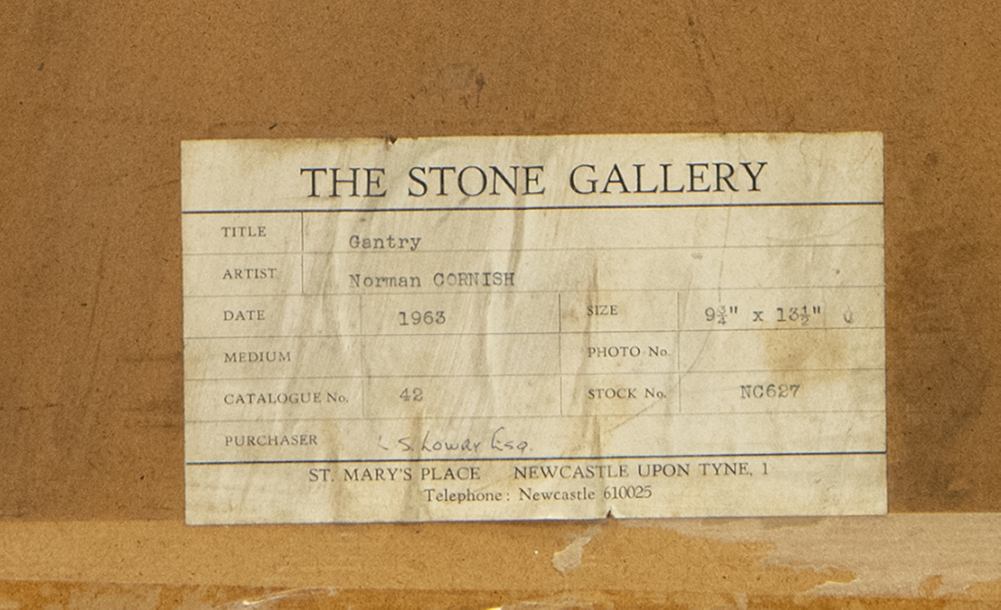
Bishop Auckland Town Hall open.
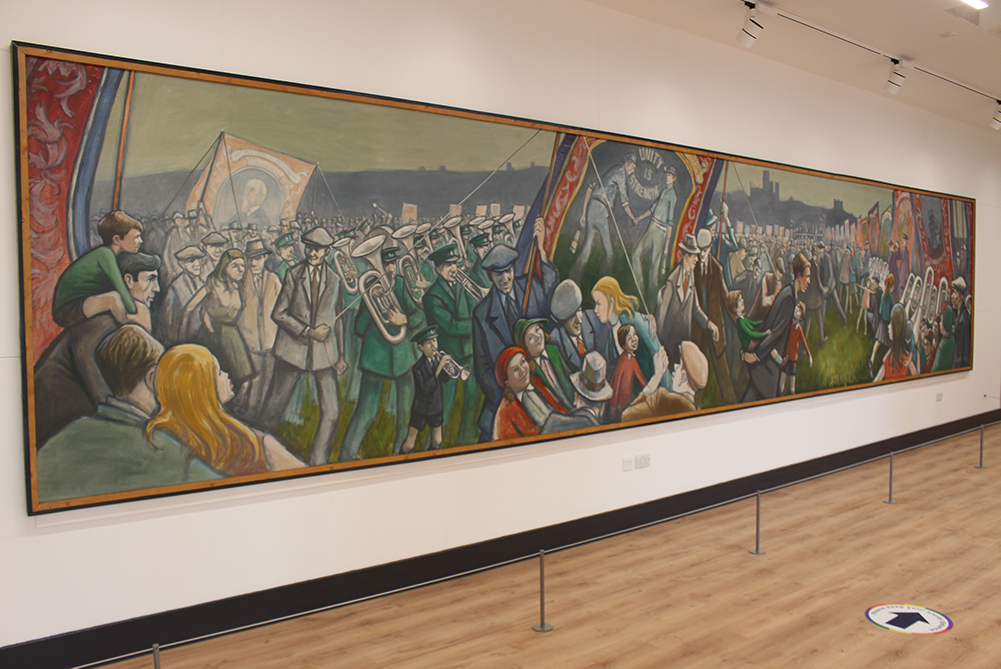
You can now visit and see the Norman Cornish Mural in its new location where it looks simply stunning.
The Bishop Auckland Town Hall was originally planned to open in April 2020 following its £1.5m refurbishment of the café, library, theatre and gallery spaces. However, due to social distancing guidance and restrictions on the reopening of theatre venues, the staff are currently only opening the café to the public.
During the past few weeks, they have been preparing the building and have undertaken a full Covid-19 risk assessment, including clear signage for customers and seating arranged to allow lots of space to move around.
On Monday 3 August, the new café/bar opened to the public and is now much bigger, brighter and relocated at street level at the front of the building, as well as temporarily in the gallery and library areas in order to create more space.
Regular opening times will be Monday to Saturday 10am - 4pm. There is no need to book and the new menu will include a wide selection of fantastic locally sourced produce.
Although the library space will continue to be closed for access to browsing and PC use, the new Pick and Collect service will be available at this site.
For more information on Pick and Collect visit www.durham.gov.uk/pickandcollect

A Hidden Gem: The Norman Cornish Trail
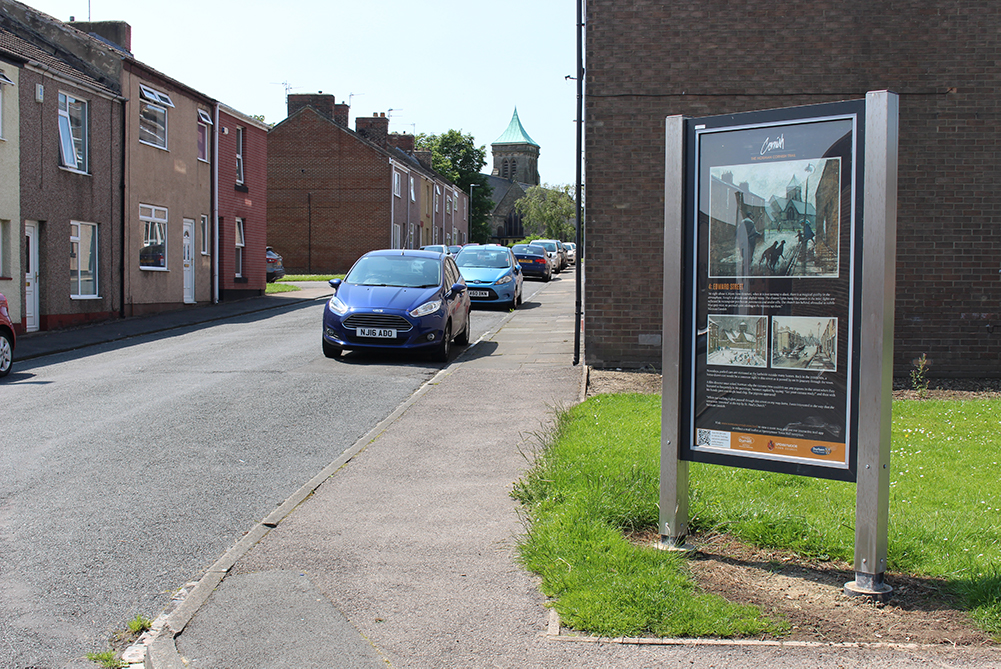
The Norman Cornish Trail in Spennymoor opened in April 2019 to launch his Centenary Year. Over 10,000 visitors have enjoyed this fascinating walk of 1.5 miles visiting 10 of the famous locations which inspired some of his most iconic paintings.
Follow in the footsteps of one of the leading 20th Century British artists in his home town and also visit the Coming Home exhibition at the Bob Abley Gallery in Spennymoor Town Hall. Free parking is available at the back of the Town Hall and the journey begins at the John Kitson Achway where a selection of Cornish’s images, wonderfully illuminated on glass panels, can be viewed. Here you can collect a free souvenir brochure guide to the trail or download a version at www.normancornish.com/trail
There are ten locations to visit and the walk takes about one hour. An audio version of the information on each panel may be accessed via a QR code at each point of interest.
In his own words:
“Spennymoor has all that a painter needs in order to depict humanity”
The Norman Cornish Trail was recently featured by Visit Durham for the July edition of North East Living magazine and if you follow the link below you can read the featured article : Discover Durham’s hidden gems this summer.

The Busy Bar: Human Drama
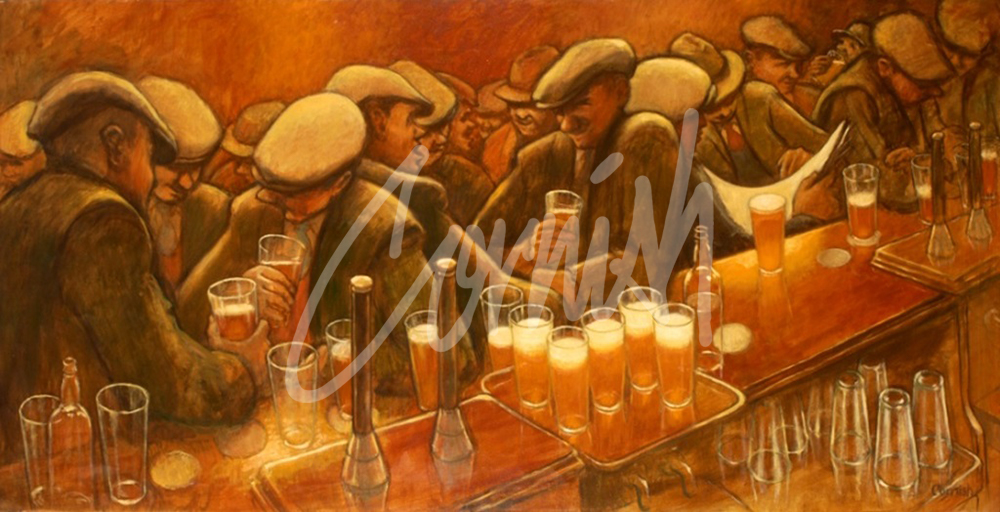
Norman Cornish’s studio is currently on long-term loan from Beamish Museum to Spennymoor Town Council, and is the centre-piece of the Coming Home exhibition at the Bob Abley Gallery. In 2014, a scrap of paper was discovered in the back of a drawer in the studio table.
The scrap of paper revealed for the first time a preliminary rough sketch of a bar scene. More significantly, there were three statements setting out the underlying principles which Cornish employed to develop the composition of The Busy Bar, which became one of his most admired and appreciated paintings.
- It is human drama based on gesture and attitudes.
- It is monochromatic.
- The accent is on atmosphere which contrasts the earthy humanism with the mysterious glitter of the beer and the glasses.
A fascinating insight, which discloses his deep thoughts about the underlying geometry of the picture. A clear and carefully considered structure, with a highly complicated design and unusual perspective from the barmaid’s view helps to invite us into this busy bar full of activity and animated conversation.
In his own words:
Again, the bar is a big diagonal shape – wide bar coming along half way up the right-hand side down to the section area of the base. Then, of course, there are other shapes teetering away from his hand, down to under the bar. It’s not too obvious, but it is two diagonals, one against the other - rather like when you see someone playing a violin. You need a violin and you need a bow to cross in order to get music. If you don’t do that, you don’t get a lot of music – it helps to create feeling. Of course, the actual men themselves created circular rhythms within the group. The circular rhythms knit together like a jersey.
As an underground miner, Cornish was fully immersed in his community. The beer in Cornish’s glasses gave him the passport to be able to share, observe and record the communal life in pubs because he was easily able to blend in and this gave him the opportunity to produce so many character drawings of his subjects.
In 1989 The Busy Bar was purchased by Scottish & Newcastle Breweries to be hung in their boardroom. In 2007, the painting was donated to The Permanent Collection at Northumbria University and it forms part of the Norman Cornish: Definitive Collection at The Bowes Museum extended from August 1st to January 17th 2021.
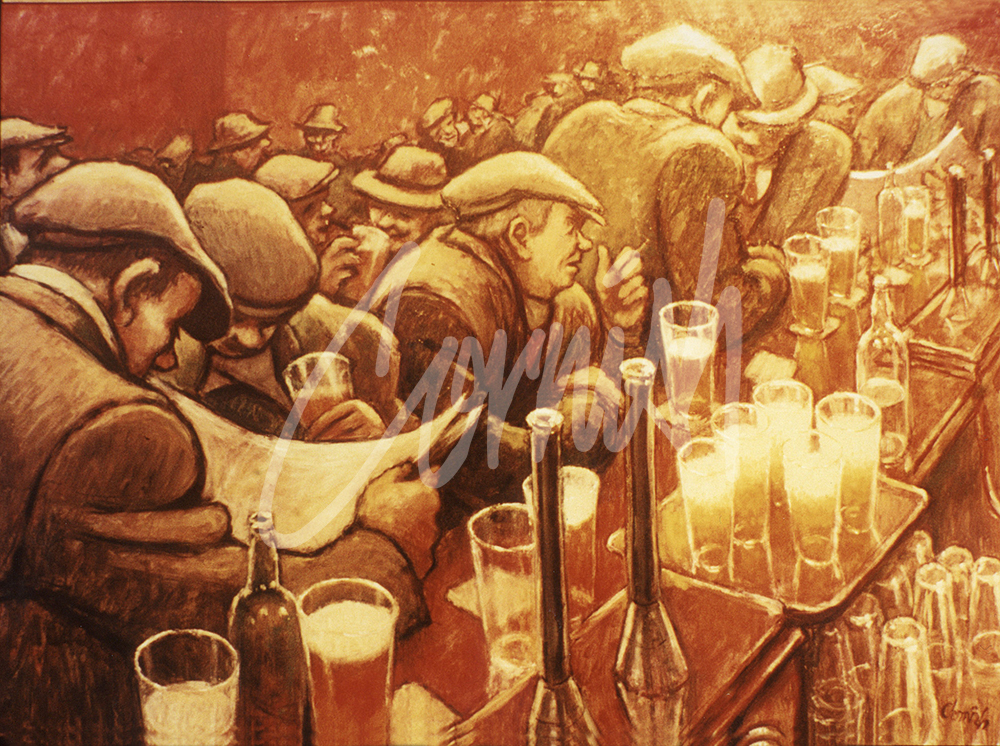
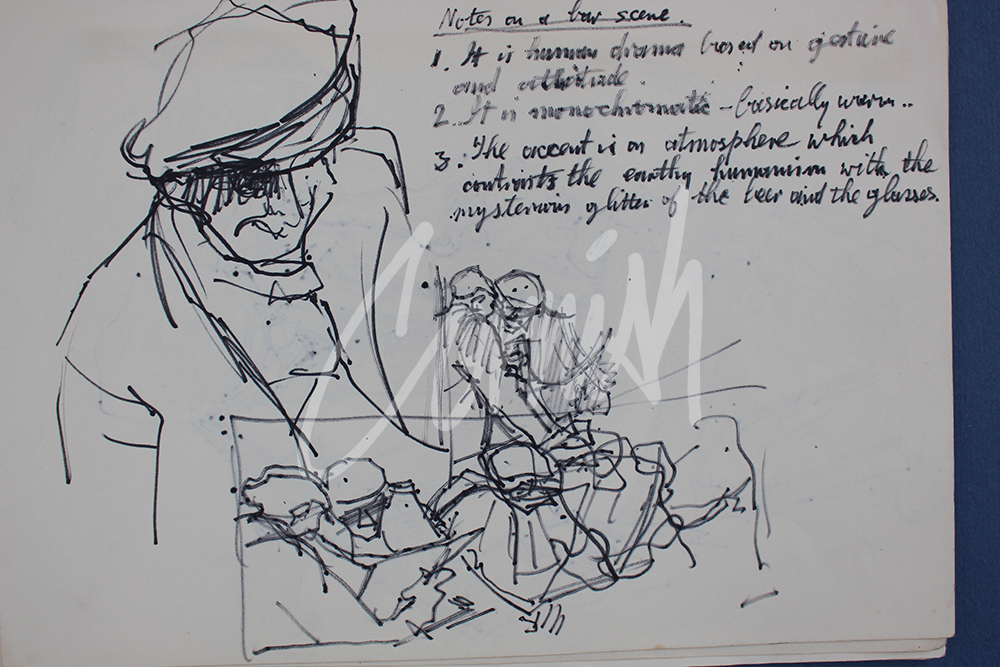
More Articles...
- Classic Cornish: The Pit Road
- Man at Bar with Dog: A Masterclass in Art Appreciation
- Classic Cornish: 2
- Classic Cornish: 1
- Norman Cornish 1991-2013 Part 2 Academic success and national acclaim
- Norman Cornish 1991-2013 Part 1 Hanging on the walls
- Norman Cornish in the 80s
- The Port of Tyne Commission Part 2 The River Tyne Pageant:
- The Port of Tyne Commission Part 1: Roll-On Roll-Off
- The British Oxygen Commission


